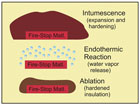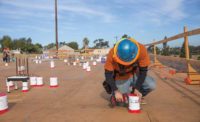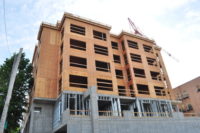A review of current fire protection regulations that pertain to plumbing installations and the materials and devices commonly used.
Cast-in-place devices are fastened to wooden forms before concrete is poured and then punched out to provide an opening through the slab for a pipe. This approach eliminates coring.
Editor’s Note: “Back to Basics” is a column that will run periodically in PM Engineer reviewing the basic principles of plumbing engineering.
Effective fire protection of plumbing pipes penetrating fire-rated walls and floor/ceilings is important because it affects long-term safety of building occupants, as well as the building inspection.

Plumbing contractors across the country will shortly be required to conform to new firestop regulations that are based on revisions to Underwriters Laboratories (UL) Test Standard 1479 “Fire Tests of Through-Penetration Firestops.” As of Sept. 20, 2007, firestops tested in wood frame construction will be tested with the penetrant exposed to the fire and not protected by the chase wall.
The present practice requires that wall cavities be rated for one hour when measured from the outside, but does not take into account the hazard that results when fire occurs inside the wall cavity. For that reason, the new UL standard requires that vertical combustible pipe penetrations through header plates inside a chase wall be firestopped at the floor/ceiling intersection with the penetrant exposed to the fire. This is a much more severe fire scenario. Systems may now require the use of much more rigorous materials, such as intumescent sealants, strips, collars or plastic pipe devices.
These intumescent firestops will expand to close off the pipe opening should a combustible pipe melt or burn away. Refer to the UL Fire Resistance Directory for specific systems that pass the revised test criteria effective Sept. 20, 2007.

Figure 1
Firestopping-A Solid Rationale
Fire protection is more than a mundane construction requirement. As incidents in many commercial buildings have demonstrated, a structure fire can create serious results with temperatures climbing quickly to more than 2000°F (1100°C). When a fire of this magnitude occurs, the resulting pressure differential can cause toxic gases to spread quickly from the origin of the fire through an entire structure. Firestopping of pipe penetrations is crucial, because even the smallest openings in walls, floors and ceilings can act as a path, allowing flames and toxic gases to migrate from room-to-room or floor-to-floor.
This pressure differential and resulting smoke propagation is the cause of most fire deaths. Smoke fills escape routes such as stairwells, hallways and elevators, preventing occupants from safely escaping. Even a single quarter-inch (6.4-mm) diameter opening in a wall or partition can cause surrounding spaces to quickly fill with toxic gases. A report titled, “Fire Conditions for Smoke Toxicity Measurement,” published in the May/June 1994 issue of Fire and Materials, (Copyright © 2007 John Wiley & Sons, Ltd.) found that approximately 75% of fire victims in the United States die as a result of smoke inhalation rather than the heat of a fire.
Effective fire protection is a system challenge. It includes the use of fire-resistant walls and floors to compartmentalize a structure into controlled segments or separate a structure into controlled compartments, with seals to close off construction joints, such as expansion joints, curtain wall gaps and floor-to-wall joints, and firestopping. The firestopping closes off annular areas around pipes, cables and other objects that penetrate ceilings, floors and walls.
The primary factors that affect the level of firestop performance in a structure that are related to plumbing are the type, size and quantity of penetrating pipes; the annular spacing between pipes and fire barriers; and the construction environment, which generally includes concrete, gypsum, steel, wood and masonry surfaces.
Effective firestop penetration sealing requires specialized products that are designed and tested to meet specific performance standards. In most cases, materials such as drywall compound, grout or conventional sealants cannot restore the integrity of a penetrated fire barrier, because they may dry out, shrink or crack over time, and may crumble in a fire. A proper firestop seal must be capable of restricting and stopping the spread of smoke and toxic combustion products under fire conditions.

Figure 2
FireStop Materials and Systems
Approved firestop materials for penetrating pipes are tested and listed in accordance to nationally recognized standards. ASTM E 814-02 (Standard Test Method for Fire Tests of Through-Penetration Fire Stops) and UL 1479 (Fire Tests of Through-Penetration Firestops) are the standards widely adopted by building codes in the U.S. Canada has an equivalent standard, CAN4-S115. There are many types of firestop penetration situations, and a combination of products may be required to meet these regulations depending on the circumstance.
Firestop materials exhibit one or more physical properties under the heat of a fire, including intumescent expansion, endothermic release of water vapor and the charring and hardening of ablation.
Most firestop penetration seal systems for plumbing pipes exhibit one or more of three special properties (see Figure 1). The first is intumesence, which is a characteristic of a material that causes it to swell when exposed to heat. Intumescent materials expand in proportion to temperature, beginning at approximately 250°F (121°C) in most cases and expanding fully at 1000°F (540°C).
The second firestop property involves an endothermic reaction. Materials with this property will release chemically bound molecules of water when the temperature rises. The heat of a fire drives water out of endothermic materials, forming steam and thereby cooling the surrounding area.
The third property is ablation. In this case, the heat of a fire erodes the firestop material’s surface to form a hard, insulating char. The ablative materials used in construction joints are designed to have elastic properties at ambient temperatures, making them ideal for filling gaps that are expected to experience structural movement due to thermal cycling, wind loads and mechanical vibration.
Firestop materials for plumbing are grouped in several basic categories, each designed for a given construction setting, type of pipe, and wall/ceiling/floor material. These products include:
Caulks and Putties-Fire-rated latex caulks have both the intumescent and endothermic properties described above. Caulks are applied to openings around pipes with a standard caulking gun to form a tight barrier against fire, smoke, fumes and water. Elastomeric firestop putties have properties similar to caulks, but are formed and applied by hand to fill wider penetration gaps (see Figure 2)

Figure 3
Watertight Sealants-A new class of single-component silicone watertight sealants provides firestopping and also prevents water intrusion through fire-rated floor slabs, walls and other building partitions and assemblies.
Flexible watertight sealants are particularly useful for fast-track construction projects where finishing work may proceed on the lower floors while upper floors are still under construction. The sealants also are good for construction situations where it is important to provide long-term protection against water flow from floor-to-floor or room-to-room. The use of these watertight firestop sealants is growing quickly, particularly in areas such as Florida where architects, building owners, general contractors and subcontractors all seek to reduce potential liabilities related to water damage, both during and following construction.
Plastic Pipe Devices-Plastic pipes that can burn or melt in a fire to leave a gaping hole in a wall or floor must be sealed by a material that expands to fill the opening as a pipe melts or burns. This can be accomplished by a pre-built metal collar assembly that contains an expanding intumescent material (see Figure 2). These devices are used for new construction as well as retrofit plumbing applications.
Cast-In-Place products are members of a new class of devices for construction to improve firestop installation efficiency for pipes that penetrate poured concrete (see Figure 3). Cast-in-place devices with integral intumescent firestop material are fastened to wooden forms before concrete is poured and then punched out to provide an opening through the slab for a pipe. This new firestop approach eliminates the need to core through cured concrete, saving construction time, equipment investment and labor. Metal or combustible pipes placed through these cast-in-place devices are immediately firestopped and no further fire protection effort is required.
New cast-in-place fire protection devices for concrete floors eliminate the cost and delay of concrete coring and provide firestopped openings for metal and plastic pipes.
Code Compliance Resources
Fire protection product manufacturers can develop and test fire protection solutions in the laboratory and provide local inspection authorities with documented confirmation of performance. This service is intended for unusual construction circumstances that are not specifically covered by the prevailing code. Subcontractors should contact their fire protection supplier for more information on custom firestop solutions.
While there are many effective, proven fire protection products on the market, the ultimate performance of each system is crucially dependent on carefully following precise installation procedures. The challenge of keeping up-to-date with both construction requirements and firestopping product solutions can be daunting for the plumbing engineer.
Fortunately, fire-protection training and application assistance resources are available from various industry suppliers, including Internet-based and self-directed training programs that allow general contractors to confirm that subcontractor employees meet performance requirements and industry standards. Major fire protection suppliers offer application engineering assistance and consulting services, as well as centralized or on-site training to help users meet code requirements.

